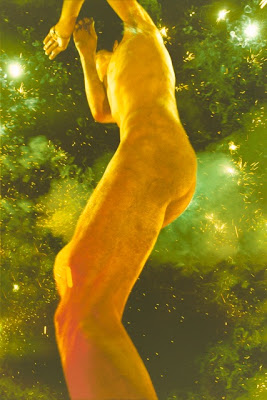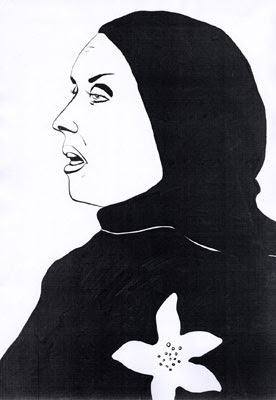Friday 31 December 2010
Two Thousand and Heaven
Save some energy, too, for Horse Meat Disco's 48 Hour blowout on the 1st and 2nd of January. The legendary Gymkhana takes over The Eagle for two nights, where the HMD regulars will play slutty disco to the regular crowd of beary, cruisey and up-for-it guys. I'm super-excited!
Friday 10 December 2010
Andrew Milk is obsessed with dogs

One grey friday night a couple of months ago, he invited me round to his place above a record shop in Notting Hill, London. I showed up late proffering beer and back-issues of BUTT as ice-breakers, and found him in his fly-posted bedroom watching telly.
What are you watching?
Roseanne. With, apparently, Joan Collins! It's her Dad's funeral and Joan Collins is meant to be her cousin.
Joan Collins: …But I really think that this is a time for families to be together.
Roseanne: Yeah, death is such an ice-breaker. [studio laughter]
She's shit!
[laughs] She's so bad. It's embarrassing, but I'm really not very familiar with Roseanne.
Oh I love it. I watched it all the time when I was growing up.
Where did you grow up?
Dunstable. It's a really small town an hour's north of London with no train station.
So what was it like growing up there as a young homosexual?
Pretty boring. A lot of waiting for something to happen that never did. There was this one effeminate guy that was friends of all the cool girls, and when he was 13 he ran away with this 22-year old man.
Oh my God, that's my dream.
He was living my dream as well. But everyone was quite obviously shocked - he just disappeared from school.
That's my next interview right there! I'm sure it all ended in tears! [laughs] So tell me how you came to start Club Milk?
It was actually started by a guy called Matt who was putting on experimental music nights when I was at art Uni in Maidstone, Kent. I joined that and it became semi-popular among the art students there, and we moved it to London in 2008. It kind of became my baby, and I was trying to turn from an experimental night into something that was a bit more underground punk/queer orientated. I was living in a warehouse in Manor House at the time, and for the first show there I put on Drunk Granny, Internet Forever, Trash Kit and Chaps, who were the first band we released on Milk Records. Everyone that was involved in DIY or queer stuff came to that show, and I guess that established Milk in London. Homocrime had catered to a similar crowd, but they stopped doing shows in 2006.
What was Homocrime?
Homocrime was these guys called Irene and Daniel who put on DIY queer punk shows in London. They would try to do a release for every show they put on, these really nicely packaged CD-Rs. They've got a website where you can download all the stuff they released, which is a really good record of what was going on in London in the mid-2000s.
That's amazing.
I'm the kind of person that's really optimistic about what one person can achieve. When I really like a band, I want to put on all their shows and be involved in every aspect of it.
How would you describe the way your band Covergirl sounds?
It's kind of guitar-driven but there's a little bit of a synth noise underneath it, so it's dance-punk! And then there's loads of vocals, and tribal choruses from everyone. Sometimes it's shouty hardcore vocals, and sometimes it's rap. So a fusion band!
Who else is in the band?
It's like a supergroup! And everyone else's other stuff is getting quite big - [Rachel's band] Trash Kit are big, [Billy's band] Wetdog are big, [Kat's band] Peepholes have got an album out now, and Ruth's becoming quite a busy artist.
Rachel was telling me about your first show at The Joiners.
Yeah, our friend Richard asked us to play at his karaoke night at the The Joiners Arms - Tranny Tuesdays! We got these black plastic eye masks and put diamanté diamonds on them and stapled them from the reverse so you could see the jaggedy stables, so it was like dangerous and punk still.
Very glamorous.
And then - you know the multi-coloured ribbon you get in corner shops when you go into different parts of the shop? - we had that underneath the masks and going down to the middle of our bodies.
Rachel was saying 'oh, we forgot to bring drumsticks, so we ended up using kitchen utensils!'
I think we ended up using a wooden spoon and a spatula as drumsticks. We played at like 1am and seven people were there, but it was a really good first gig! I'm really pleased that we were able somehow to pull that together, with a couple of practices and doing it on the fly.
What tattoos do you have?
I only have one, which is the collie dog. I'm maybe unhealthily obsessed with dogs. Whenever I see them I get that kind of feeling some people have with babies - a really paternal instinct. All I need to do is look at a dog and I just smile. My next tattoo is going to be - you know the Ouroboros, the snake eating itself? - I'm going to get a dog chasing its own tail around my arm.
Why did Matt originally call the night Club Milk?
I don't know. It's really weird, because Milk has a lot of meaning personally for me. It's something that I really really enjoy, but I can't have it 'cause I'm slightly lactose-intolerant so it's like forbidden fruit. And plus with Harvey Milk it has a really good queer connotation to it.
What's your favourite Milk-based food?
I have to have a glass of milk with any dessert. More than one. What's good is obviously having a biscuit that you can bite both ends off, and then you can drink the milk though the biscuit.
But doesn't the biscuit dissolve?
Well it will if you keep doing it. But if you just suck it up to the top and then eat it, you've got a really delicious milky biscuit.
I guess I don't know when to stop.
Yeah, you've got to know when to stop.
Friday 3 December 2010
Ryan McGinley Interview

Portrait by Jack Pierson
Funny story: This summer I got scouted by Ryan McGinley. I was walking up Broadway in New York when a petite blonde girl cornered me: "Excuse me, do you have representation?" Honey, the only thing I'm representing is the ability to work braces and army boots in this 90 degree heat. Why do you ask? "I work for a photographer, and I think you've got the perfect look for one of his shoots." I took the proffered glossy business card. 'Ryan McGinley'. What, the New York photographer, enfant terrible of the 00s Ryan McGingley? What the…
While photographer Nan Goldin and filmmaker Larry Clark were seducing the art world in the 90s with their visceral depictions of New York down-and-outs, Ryan McGinley was photographing a side of the subculture that was liberated and joyous. He took pictures during sex with his boyfriend, of his friends stealing Kiehl's toiletries from houseparties and graffiti artists scaling public buildings. Amidst a whirlwind of hype and hyperbole, he became the youngest person ever to be given a solo show at The Whitney Museum of American Art in 2003. He was 25. His show The Kids Are Alright became emblematic of a new optimism against the bleak backdrop of a post-9/11 art world, and he hasn't stopped since. In addition to touring with Morrissey and making a short film with his "brother from a different mother" Tilda Swinton, Ryan's taken a roster of models (he calls them his 'children') on extended nude photoshoot trips across the USA every summer since 2005 .
My shoot with Ryan never happened (maybe it would break his rule about keeping the personal and professional separate), but we've remained friends ever since we met that day. His sense of wonder and adventure is infectious - with him you learn to expect the unexpected. A Hyde Park picnic leads to splashing with kids in the fountain, a quiet night in becomes dancing to Dr Dre on a rooftop 'til the early hours. Below, he tells us about his latest summer adventure, not masturbating, and why his photos aren't erotic.
Um, it's nice. It was a little bit weird at first, 'cause you kind of go through withdrawal from being away with 15 people for a month straight. But then I guess you fall into the New York state of mind.
Where did you go on your trip this time?
From New York we went west through Ohio, up into Iowa and Minnesota, and then we came down through Colorado, and then cut over to Kansas, and then went down, through Tennessee, and then back up the East coast to New York.
That's an incredible about of land!
[laughs] Yeah, we covered a lot! Everyone was nude in all the shoots, and I was just trying to find the best kind of natural landscape that I could. We shot in Michigan one day, and we flew kites. That was was really cool - just these really beautiful sand dunes with green grass popping up everywhere, and nude people flying kites. And then I did a lot of stuff with fireworks also. They're really nice, the way they light people's skin. It's just such a beautiful light that comes out of them - it's really unexpected.
I think your photos are sexually charged though. The models in your Everybody Knows This Is Nowhere studio series have an openness which is kind of sexy.
You know, I think it's vulnerability more than anything. I would say that my black and white studio portraits are a lot more intimate than my colour work. But I think it's more of how the viewer kind of interprets the person's feeling or the look in their eyes.
Do you find it easy to have a split between professional dealings with sex and nudity, and then your personal sex life and being turned on?
Yeah, more so now than it used to be. When I first started making photos I photographed my first boyfriend all the time during sex and other really intimate stuff, and then at a certain point it started to change and I began to start setting photoshoots up and going on trips. On the first trip that I went on I brought this guy that I was dating along, and it just didn't work out, 'cause it was sort of like bringing your boyfriend to work, you know? There were deep emotions tied up with it, and as the years have gone on I don't do that any more. When you do these long journeys you have to be in the mindset, the same way that a boxer prepares for a fight - a boxer won't masturbate for a few months before his big fight. You just have to keep really focused, and you can't really mix the two.
So you grew up in Ramsay, New Jersey as the youngest of eight.
Yeah. It was strange! My Mom had seven kids in seven years, and then eleven years later she had me. My parents were involved in my life, but my brothers and sisters wanted to be my parents and to take care of me. It was amazing, because I was around all these wild teenagers. My eldest brother was a real rocker, and then I had a brother who was really into the stock market, and we would go through supply and demand. And my sisters were really into Adam Ant, and then one of my brothers was gay - he was a drag queen and his boyfriend was a Barbara Streisand impersonator.
[laughs] That's amazing.
Yeah, I started coming to New York to stay with him and his boyfriend from the age of about four. They would do these little drag shows for me - my brother did the Wicked Witch of the West and his boyfriend did Barbara Streisand. I just have memories of being so fascinated, and having really fun sleepovers and laughing a lot. But then as I got older my brother got AIDS and then he got sick, so that was really a big part of my life. It was tough, because it was before the protease-inhibitors and all the drugs that keep people alive and healthy. It was really a pretty hardcore AIDS death, and going through the steps of that was part of my teenage years. That was definitely really hard, and I think that it has had an effect on the kid of work that I make. My work is really about celebration and about freedom and stuff like that, and that's a response to those years which were about suffering, and the complete opposite of that.
You've told me before that you like being gay because it gives you a questioning perspective - do you think that your brother was formative in instilling that?
Yeah. I think that it was all my brothers and sisters - I was definitely raised to question authority. My teenage years involved drastic changes in subcultures based around drugs. I was always kind of punk, because I was always a skater, so that was the initial subculture that revolved around [punk bands] Fugazi and Operation Ivy and stuff like that. And then I started going to Grateful Dead shows and doing acid, and then that sort of led into more of like a rave thing. I started going to New York, and going to these clubs called N.A.S.A. and The Limelight, and I experimented with ecstasy and Special K. And it wasn't like my family promoted it, but it wasn't an issue when I got home, just as long as I could keep my grades up!
What did you look like in your days as a raver?
[laughs] Well rave culture had kind of evolved, and there were these things called Polo Ravers, which were kind of like this morph between Hip-Hip and a raver. There was a period from 1993-94 when Ralph Lauren made these really super-beautiful clothes in insane primary colours, and we would wear like head to toe XL Ralph Lauren clothes. That's what we wore, and we would also wear these baggy pants from this store called Liquid Sky that Chloë Sevigny used to work at. She was part of the scene, and we'd all hang out in Washington Square Park and go dance all night.
I'd love to see a picture of you from back then, that sounds amazing!
That's the thing - I don't really have many pictures of me when I was younger, because I wasn't really into photography and it was before digital cameras. It's sad - I feel like that's why I take so many pictures now!
And you love to take mini-movies on your iPhone!
[laughs] Yeah, all the time - everyone's always getting on my case about it! I love making movies. I make photographs for the sake of art, but I still have that side of me where I just want to make photographs of my friends with my cell phone. Those are the photos that I love the most, actually.
Well, you first became acclaimed for doing exactly that - for taking photos around New York and of your friends. What was that whole time like?
R: It was just so fast that I can't really remember. Basically I was on a lot of drugs. I was just this crazy downtown kid who was out every night of the week, going crazy on rooftops, bars, and running in subway tunnels. But I always had my camera on me, and I was always taking pictures. And there were a lot of people who really helped me out and supported me. I guess the first thing was that Index [legendary New York arts magazine which ran from 1996-2005] published a book of my work - that's when my career really took off. It was just insane after that, and it's never stopped since then.
How your film with Tilda Swinton come about?
Our joke is that we call each other 'brothers from different mothers.' I feel like that she's the cutest boy! When she dresses in more boyish clothes, she's totally like a boy that I would be interested in. Basically Pringle of Scotland asked me to do a project for them, and one of their requirements was that they had to use a Scottish person as their actress, and of course immediately I was just like 'Tilda Swinton!'
[laughs] Sure.
Like, no two ways about it.
Was it filmed on her island?
Yeah, it's shot on the island where she lives - it's like three hours from Glasgow. The first day we started I had a lot of really crazy ideas, and the production people were like "I don't think you should as Tilda to do that, maybe we should get a double." And there was just this one moment where she saw me from across the way, and I think she knew what was going on, and she pulled me aside and said "whatever you want me to do, just ask me and I'll do it for you. I believe in your artwork so much."
Awesome.
It was the most special moment where we totally just clicked, and I knew that it was just two artists together. She did all this stuff in this film that was really difficult, you know? Like, we went into these really tight tunnels in this crazy cave, and she crawled through this window that was, like, the size of a large book and hanging off the side of this castle. I just have so much respect and love for her that she did that for me. And then I had dinner round her house, and it was really good.
What did she make you for dinner?
She made some really nice fish. She's a very healthy eater, and it was just great to spend time with her and her kids at her house.
Your first photography book now goes for crazy amounts on the internet - does that feel weird?
Not really. I don't get weirded out by anything. I'm very open to whatever.
Yeah, I think you're pretty grounded.
I feel pretty grounded. I live my life to be a good person, and I try to be as good as possible. I've been listening to a lot of Nina Simone lately, and she does this song Don't Let Me Be Misunderstood.
Oh, I love that one.
There's this line in it - I probably won't get it right - but it's like, 'No-one alive can always be an angel, but I'm just a soul whose intentions are good, so please don't let me be misunderstood.' That's kind of like how I feel, you know? I definitely try my hardest to be good, but obviously you can't be all the time! [laughs]
Totally.
I don't wanna be misunderstood.
Tuesday 30 November 2010
Freddy Ruppert Interview
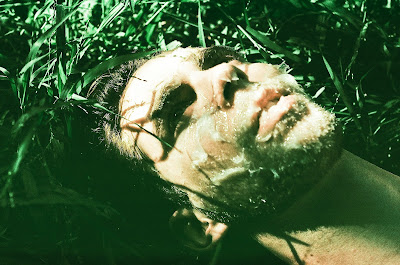
For the past couple of months, I've been listening to Former Ghosts' intricate and quietly devastating record New Love on pretty much a daily basis. Just before the album's release, I talked to the frontman Freddy Ruppert about facials, rap music and dipping things in peanut butter. An edited version of the article below appeared in the November issue of Attitude.
When a photo flashed up in my inbox of Freddy Ruppert with a face full of spunk, I couldn't quite believe our eyes. "It's not a reference to having sex in bushes!" he insists, laughing. "It's more of a metaphor for being caught up in that insane post-relationship sexual stuff, and how i'm kind of crazy with jealousy issues regarding that."
Freddy could easily pass muster as an indie pin-up with his handsome looks, but that was never part of the plan. He's the frontman of Former Ghosts, a synth supergroup of sorts which also includes Jamie Stewart of post-punk experimentalists Xiu Xiu and Nika Roza Danilova, a.k.a. noise-popstar Zola Jesus. Hot on the heels of last year's critically-lauded debut Fleurs now comes the trio's latest release New Love, which Freddy admits is "a lot darker of a record, but kind of poppier." Album highlight 'Chin Up' is a synth-led paean to self-effacing love, with vocalist Nika's plea of 'I need you right now' coming with the admission 'this will bury me', her operatic vocals driving the song to its desperate crescendo.
In person, Freddy is warm and easily tickled, and effuses self-deprecating charm. "I listen to a lot of American Top 40 R'n'B, where the lyrics are about real straightforward, universal themes," he explains in his LA twang. "I think that influences the way I write lyrics - I don't consider myself a good lyricist, I just want to sing exactly what I feel."
When he's not covering himself in fake semen for photoshotos,or drinking himself into vomit-inducing oblivion (see Former Ghosts' 'Hold On' music video), Freddy's adding to his burgeoning tattoo collection. He's a man who wears his heart on his sleeve - really - it's a 50s-style design with a 'Mom' scroll. "My Mom passed away when I was 19 so me and my brother went and got that. It was the first tattoo I'd ever gotten, and I thought it would be a nice tribute to my Mom - but also funny that I had a tattoo that was so sailor-tough or biker-tough!"
So what makes Freddy Ruppert happy? "Peanut butter!" He lights up: "I feel like it's one of the top five reasons I actually stay alive. It's so good to just open up a jar of peanut butter and just dip chocolate items into the peanut butter jar. That's just, like, perfect."
When I went to see Former Ghosts play with Zola Jesus and Xiu Xiu earlier this month, I couldn't help myself popping into Sainburys and picking up a Kit Kat and jar of Skippy for Freddy. When I presented it to him he creased up laughing: 'You know I'm gonna dip this into the peanut butter!' Well, yes. Unfortunately I didn't get to see him eat the confection in person, but luckily Upset The Rhythm TV immortalised the moment at the end of the charming video below.
Upset The Rhythm TV #13: Former Ghosts vs. Zola Jesus vs. Xiu Xiu from Charles Chintzer Lai on Vimeo.
Saturday 15 May 2010
Fijación Oral
Yet, as Shakira has noted, a child who is not fed enough (or too much) may develop a Fijación Oral. The orally-fixated person reduces tension with activities like eating, drinking, smoking, nail-biting, and giving oral sex. They will easily 'swallow' other people's ideas.

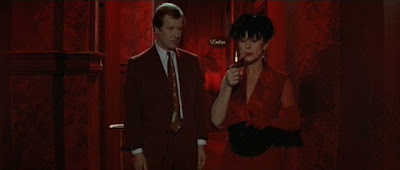


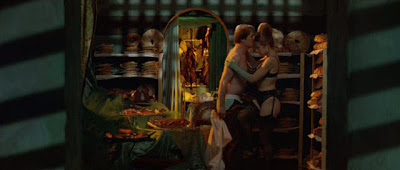

Stills of Helen Mirren in Peter Greenaway's The Cook, the Thief, His Wife & Her Lover (1989).
Saturday 1 May 2010
Bette's BlooLips
 Often, avant-garde theatre and performance doesn't receive the attention it deserves - and I'm talking about myself as much as anyone else. The nature of performance art is that it only happens once (or for a finite period of time) and if you snooze, you lose. There's something about the spontaneity of the form, though, that affords it a unique place in the arts. It happens in the zeitgeist of the moment, and it doesn't stick around to become institutionalised.
Often, avant-garde theatre and performance doesn't receive the attention it deserves - and I'm talking about myself as much as anyone else. The nature of performance art is that it only happens once (or for a finite period of time) and if you snooze, you lose. There's something about the spontaneity of the form, though, that affords it a unique place in the arts. It happens in the zeitgeist of the moment, and it doesn't stick around to become institutionalised.I was doing some research on the early days of the Gay Liberation Front earlier today, and came across the figure of Bette Bourne (left), who - aside from being a glamourpuss to rival Lady Crisp - was instrumental in the GLF activism of the early 70s.
In 1971, the Church organised a morality campaign called the Festival of Light, supported by the grotesque bedfellows of Mary Whitehouse and Cliff Richard. The Festival of Light preached of the vast moral evil that existed in the society of the time, which included extra-marital sex, abortion, and 'gay lifestyles'. For their protest at the launch of this campaign, Bette Bourne and the GLF introduced a new style of political campaigning, called 'protest as performance':
"Mice were released into the audience; lesbian couples stood up and passionately embraced. A dozen GLF nuns in immaculate blue and white habits charged the platform shouting gay liberation slogans, and a GLF bishop began preaching an impromptu sermon which urged people to 'keep on sinning.'"
 Bette was an actor (darling) first and foremost, and post-GLF she formed a theatre troupe called BlooLips. BlooLips toured the UK and Europe through the '80s and early '90s performing spectacles of excess with tempting titles such as Look Back in Angora and Lust In Space. I was thrilled to stumble across a short documentary about BlooLips by Michael Kasino, which is embedded below for your viewing pleasure. It's funny, warm-hearted, and genuinely worth a watch. The scene from Get Hur with a ukulele/kazoo band used as torture had me in hysterics - which no doubt is related to my past co-habitation with two uke-enthusiasts (I'm sorry Jess and Victoria, but it really did drive me up the wall).
Bette was an actor (darling) first and foremost, and post-GLF she formed a theatre troupe called BlooLips. BlooLips toured the UK and Europe through the '80s and early '90s performing spectacles of excess with tempting titles such as Look Back in Angora and Lust In Space. I was thrilled to stumble across a short documentary about BlooLips by Michael Kasino, which is embedded below for your viewing pleasure. It's funny, warm-hearted, and genuinely worth a watch. The scene from Get Hur with a ukulele/kazoo band used as torture had me in hysterics - which no doubt is related to my past co-habitation with two uke-enthusiasts (I'm sorry Jess and Victoria, but it really did drive me up the wall).Bette's activist mentality is out in force, too. Near the end of the documentary she sneers - totally deadpan - 'Thank goodness we're finished now, we can go on holiday. I live for holidays.'
Get Hur, indeed!
Sure, I've no doubt that you really had to be there to experience Bette's 'protest as performance' - and given a time machine, the first thing I'd do would be to don a nun's habit and get my ass down to the Festival of Light in 1971 to preach on the pleasures of 'sinning'. In the absence of such technologies, however, I can be grateful for the existence of this footage of Bette and the BlooLips, and be inspired by her voracity and dedication to fighting the good fight.
'BlooLips' 1993 from Michael Kasino on Vimeo.
For more Bette, check out her interview in The Times from earlier this year!
Thursday 29 April 2010
"Cruising-Curious"

I feel like Belle de Jour.
A couple of weeks ago, I was asked by Time Out to write an article about the reality of cruising in London in 2010 for their Sex Issue. I was excited at the prospect, and took to burying myself in the British Library, lost in social histories of gay London and dense queer theory debates.
Fascinating as the research was, it all felt slightly too academic. Here I was in my ivory tower writing an article about strangers fucking in public, without having any experience of what it was actually like to be that stranger or that one being fucked. I had to take it to the streets.
The following article was the fruit of my labours - an edited version of which appears in this week's Time Out:
As my eyes adjust to the dimness, I begin to make out the figures who line the path. I give each one the up-and-down – there are teenagers and septuagenarians, men who dress like shop workers next to city slickers. This is not Gaydar, where you scroll through pages of guys before settling on one – this is personal.
It was with trepidation and buzzing excitement that I’d clambered on to Hampstead Heath on this balmy spring evening. Sweaty-palmed, I’d navigated the muddy slope leading down to the West Heath from Jack Straw’s Castle, all the time thinking: Why am I doing this? As soon as I reached the main path, it was clear that something queer was going on. And now, with solitary men sizing each other up, and sizing me up, there’s no going back: I’m cruising, for the first time in my life. I quickly figure out the ground rules: talking is the ultimate no-no. Instead, communication is made thorough looks, raised eyebrows, and the subtlest of gestures. A stoke of the eyebrow means you’re interested, a jerk of the head indicates ‘follow me’, a couple of pats on the forearm ‘no, thank you’.
I’d always been put-off by the idea of cruising. Not that I had anything against it, you understand – it just seemed dangerous, messy, and cold. London has gay bars and clubs catering to every niche – Heaven in Charing Cross for twinks (slim young-looking boys), XXL in London Bridge for bears (heavy-set and hirsute guys), The George & Dragon in Shoreditch for hipsters – so why would I settle for having sex with just anyone on Hampstead Heath?
Cruising is nothing new. In the eighteenth century, gentlemen would gather in private rooms known as ‘molly houses’ to cross-dress and meet sexual partners, away from the judgemental eyes of society and the law. But, as charming as this was, it was chiefly the preserve of the wealthy, offering no relief for the everyday guy. So what was a closeted Georgian to do? Well, they took their illegal desires outside, and have done ever since. London’s parks became prime spots for men of low standing to get their rocks off, offering – unlike the street or urinals – a relative safety from observation. From St. James’s Park in the 1700s to Hyde Park in the 1920s, and to Russell Square in the latter half of the twentieth century, there is practically no open space in London that has not been appropriated by gay men for cruising at one point or another. Hampstead Heath really took off as a cruising hotspot after the World War II. Initially the ponds were where men went to see and be seen, but inevitably looking wasn’t enough. Men took their desires into the bushes, and in recent decades it’s the West Heath that’s become the hub of cruising activity.
Whereas cruising was a necessity in days gone by, these days it’s easier for a gay man to have sex than to buy a pint of milk. You can cruise guys on Gaydar at home, or with Grindr in your local Starbucks. Why trek through the mud on Hampstead Heath looking for sex when you can have it in the comfort and privacy of your own bedroom?
‘So why am I here?’ I ask myself, stumbling through the murky Heath’s overgrowth. Suddenly ‘UpforitE2’ on Gaydar, who lives a few doors down from me, seems increasingly appealing. Beginning to feel emboldened, I give the guys characters: there’s a Sci-Fi Nerd (a cute chubby teenager with floppy dark hair), Shell Suit (you couldn’t not hear him coming) and Sal (who bears an uncanny resemblance to the torturously closeted Mad Men character of the same name) among many others.
It’s time to take the plunge. I attempt to cruise a tight T-shirt clad guy who wouldn’t look out of place on the cover of Men’s Health. While I’m desperately trying to make eye-contact, he gives me an incredulous look and pointedly turns his head away. Although this is about as anonymous as sex gets, that doesn’t mean that it’s entirely without emotion – and getting snubbed hurts.
The cruising ground has an unspoken sense of camaraderie, though. As I squelch through the dirt I hear a voice: ‘Get out the mud!’ I turn to see a guy in his thirties laughing, smiling at me – he’s a seasoned cruiser, I’m a newbie, and we’re both in on the joke. ‘Thanks’, I mutter, gratefully returning the smile and moving on to the dry path. We all know what we’re doing is taboo, and we’re all in this together. Cruisers are willing to help a brother out, and, surprisingly, it feels safe.
So, is there anything sexy about looking over your shoulder the whole time for police, getting scratched to death by thorns, and having the life buggered out of you by a man you wouldn’t look twice at in a bar? Frankly, there is.
Cruising liberates you from the idea of what a hook-up should look like. I would be lying if I said that the Heath is a place where appearance and age are irrelevant, but it is true that in the gloom these things matter a lot less. The fleeting encounters you have when cruising lead to an understanding of the have nots in gay culture – the flabby, the closeted, the small-dicked.
Technology has permanently changed the face of cruising, taking away the risk, the mess – and a lot of the excitement. Cruising on the web is a double-edged sword – simultaneously creating virtual intimacy, yet often failing to deliver actual human contact. It would be callous to dismiss the internet as only creating isolation, though. Websites dedicated to old-school cruising are vital in spreading knowledge of established cruising spots to the uninitiated, and offering tips on safety and etiquette – I don’t know what I’d have done without squirt.org.
My night on the Heath was the hottest I’ve had all year. I got on the tube not only sexually gratified, but with a feeling that I’d been a part of something special – and nothing about it felt sleazy. Will I do it again? Try and stop me!
Tuesday 27 April 2010
Beehives and Becky Sharp
I'd first read about Paley in the preview Issue 0 of The Gentlewoman, where she talks of her love for Sissinghurst and Vita Sackville-West's gardens ('very inspirational'), setting up her first gallery in her Hackney home in 1984, and her inimitable beehive. She comes across as a forthright businesswoman, but what's really affecting is her sense of emotion and wonder. I've never been more tempted to see an astrologer than after reading Paley's description of seeing a Jungian psychologist who reads the stars scientifically. 'It was like consulting an oracle', Paley says, 'she described a huge task I would undertake'. But the accompanying Paul Wetherall portraits really consolidated my appreciation for Maureen and her mop - attained simply by backcombing and hairspray.
Is admiration for a hairstyle a justifiable reason for visiting a gallery? That remains to be seen - but I can certainly think of worse motives. Last week, I trotted down to Bethnal Green to check out Donald Urquhart's Bi at Maureen Paley's two adjacent galleries. Urquhart has fascination with divas of yesteryear - literary heroines, silver-screen stars and faded icons. His stark black-and-white drawing style recalls graphic 1940s Hollywood publicity shots, but it also has a hand-drawn emotionality reminiscent of comic books.
Before achieving recognition as an artist, Donald Urquhart had been a postman, fashion journalist and party promoter. When he was rejected from Glasgow Art School in the 80s, he travelled from his native Scotland to become a part of the thriving London performance art scene headed up by Leigh Bowery. In the 90s he ran a club night called The Beautiful Bend, which brought his first taste of success in the art world. At The Beautiful Bend, Urquhart plastered the club walls with photocopied line-drawings of gay characters, gothic plague-doctors and camp heroines. It was only a matter of time before his work was spotted by photographer Wolfgang Tillmans, and later she of the beehive herself, Maureen Paley.
Bi is a curious title for an art exhibition. On the surface, it refers to the fact that this show takes back in two different spaces, a couple of doors down the road from each other. But it the name is also reflective of the diversity of Urquhart's subject matter - as he says, 'biographical works as well as an array of bitter pieces, instructional wall charts and studies in style.' Urquhart combines elements from disparate sources to create a new enquiring subject.
Take, for example, Urquhart's new muse in Bi - Becky Sharp, the mendacious anti-heroine of Vanity Fair. In Urquhart's portraits, Becky appears as Bette Davis, whose acid-tongued persona is a perfect fit for the character.
The drawings of Bette in the role function as a trailer for a Davis-starring Vanity Fair adaptation that doesn’t exist. We all know the feeling of building up our own (often inaccurate) picture of what a fictional character looks like, and creating our own visions of the person in our mind's eye. Urquhart gives us a glimpse into his own private adaptation, fusing the real and the fictional in order to create something that is ambiguous in its could-have-been-ness. Urquhart's vision is essentially a more subtle version of Francesco Vezzoli’s Trailer for the Remake of Gore Vidal's Caligula, a teaser for a movie that never has and never will exist.
His Joan Crawford As Mildred Pierce is a stark, flattened-out representation of the star - but this is no Warhol's Marylin. Whereas Warhol made
Fundamentally, Urquhart is interested in the women behind the image. His admiration is not for the glossy surface- his fetish is for the real, often tragic, people beneath. His Little Edie is tender, not grotesque; his Crawford is poised, ready for whatever the world has to throw at her. In Bi, we experience Urquhart's heroines as idiosyncratically as he does, and are encouraged to join him in appreciation.
Bi by Donald Urquhart is at Maureen Paley until 23 May.
For more on Donald Urquhart, check out his excellent article Four Women in MAP.
[Below: Little Edie Flower, 2007; Donald Urquhart at the
Monday 26 April 2010
Creamy Goodness
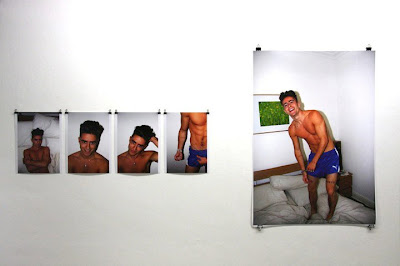
My talented and charming friend Stuart Sandford just opened his first ever solo show - entitled TWINK - at Gallery Daeppen in Basel, Switzerland. His work explores adolescent sexuality and pin-up fetishism (themes never far from my mind) and I was flattered when he asked me to write the exhibition text for the show.
TWINK by Stuart Sandford is at Gallery Daeppen, Basel, until May 8th.
Check it out if you can!

Monday 19 April 2010
Not Myra's Place
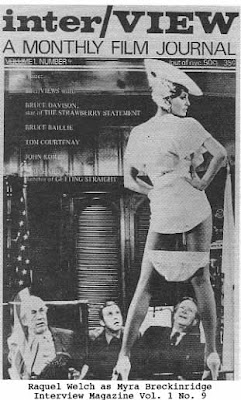 I almost called this blog something completely different – ‘Myra’s Place’, after Gore Vidal’s heroine Myra Breckinridge. I recently read Myra Breckinridge, and was enthralled (and half-appalled). Myra is a Hollywood-obsessed dame living in 1960s Los Angeles, and the novel takes the form of her diary. She is also – and I quote – ‘a dish, and never forget it, you mother-fuckers’.
I almost called this blog something completely different – ‘Myra’s Place’, after Gore Vidal’s heroine Myra Breckinridge. I recently read Myra Breckinridge, and was enthralled (and half-appalled). Myra is a Hollywood-obsessed dame living in 1960s Los Angeles, and the novel takes the form of her diary. She is also – and I quote – ‘a dish, and never forget it, you mother-fuckers’.The novel follows Myra on her quest for vengeance against the male species. You see, her recently-deceased husband Myron was a ‘fag’, and a power-bottom to the extreme who aimed to possess (straight) men by taking their forbidden cock. Alas, Myron’s insatiable lust for power (i.e. cock) just couldn’t be satisfied, and he killed himself. So Myra takes it into her hands to exercise revenge on the male species, to emasculate them and rob men of their macho supremacist bullshit for once and for all.
Sure, there’s not much that pisses me off more than macho bullshit, and I toyed with the idea of playing Myra. She is, after all, full of fascinating theories, not least her insight that between 1935 and 1945 no irrelevant film was made in the USA, and in these movies – only these – the full spectrum of the human condition can be glimpsed. But, ultimately, playing Myra was too big a task for me. I find the films of Hollywood’s Golden Age fascinating – and I plan to dedicate a number of blog entries to them – but many of them are transparently propagandistic and inane star vehicles.
So I decided to name the blog after a line from one of one of my favourite movies – the 1958 Douglas Sirk film Imitation of Life. It’s often forgotten these days, but at the time it was Universal’s highest-earning film – surpassed only by Jaws in 1975. The film is a double-headed maternal melodrama – a white mother who neglects her daughter in view of her career, and a black mother whose mixed-race daughter runs away to make her own life as ‘white.’
Let’s fact it though – Ibsen this ain’t. The script is cliché-laden and often saccharine to the point of sickliness. With a lesser director, Imitation of Life would be close to unwatchable, but through Douglas Sirk’s (Brecht-trained) lens, Imitation of Life becomes a painstaking exercise in human selfishness, claustrophobia, and miscommunication. It’s one of the most pessimistic films I’ve ever seen.
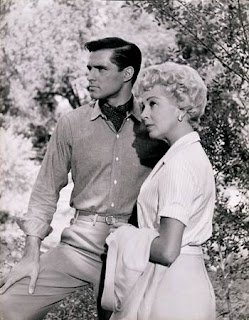
About halfway through the movie, a neckerchief-clad John Gavin confesses to Lana Turner that he’s bored of his life as an Ad Man. Flute trilling in the background, he utters the words that every homo the world over has felt at one time or another:‘Did you ever get the urge to let yourself go and follow the wind or a star, maybe even a dusty old rainbow?’ To explain the significance of the metaphor would be an insult to your intelligence.
I imagine Douglas Sirk reading this passage in the script for the first time, thinking that it was ridiculous, and what should he do? Tone it down or camp it up? He trusses Gavin up like a Christmas tree and hams up the melodramatic music – Lana Turner, of course, needs little help in looking comically expressionless.
And, like Sirk, we can react, we can laugh, we can call 'bullshit'!
This will be a blog about movies and being a homo in London, and I’m very happy to have you here.
